1997 TOYOTA TACOMA towing
[x] Cancel search: towingPage 29 of 221
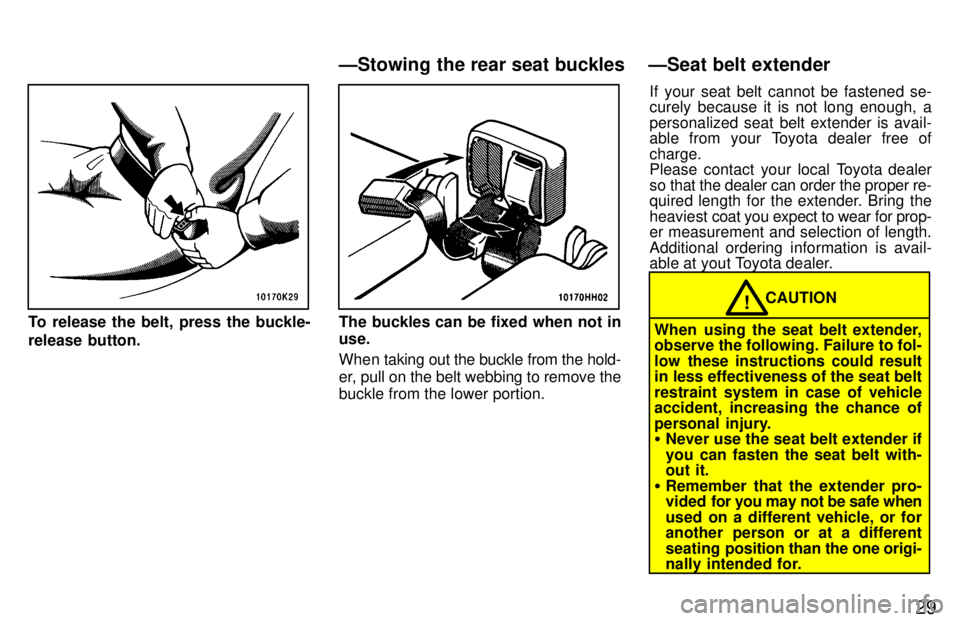
29
To release the belt, press the buckle-
release button.The buckles can be fixed when not in use.
When taking out the buckle from the hold-
er, pull on the belt webbing to remove the
buckle from the lower portion.If your seat belt cannot be fastened se- curely because it is not long enough, a
personalized seat belt extender is avail-
able from your Toyota dealer free of charge.
Please contact your local Toyota dealer
so that the dealer can order the proper re-
quired length for the extender. Bring the heaviest
coat you expect to wear for prop-
er measurement and selection of length.
Additional ordering information is avail-
able at yout Toyota dealer.
CAUTION!
When using the seat belt extender,
observe the following. Failure to fol-
low these instructions could result
in less effectiveness of the seat belt
restraint system in case of vehicle accident, increasing the chance of
personal injury. � Never use the seat belt extender if
you can fasten the seat belt with-
out it.
� Remember that the extender pro-
vided for you may not be safe when
used on a different vehicle, or for
another person or at a different
seating position than the one origi-
nally intended for.
ÐStowing the rear seat buckles ÐSeat belt extender
Page 59 of 221
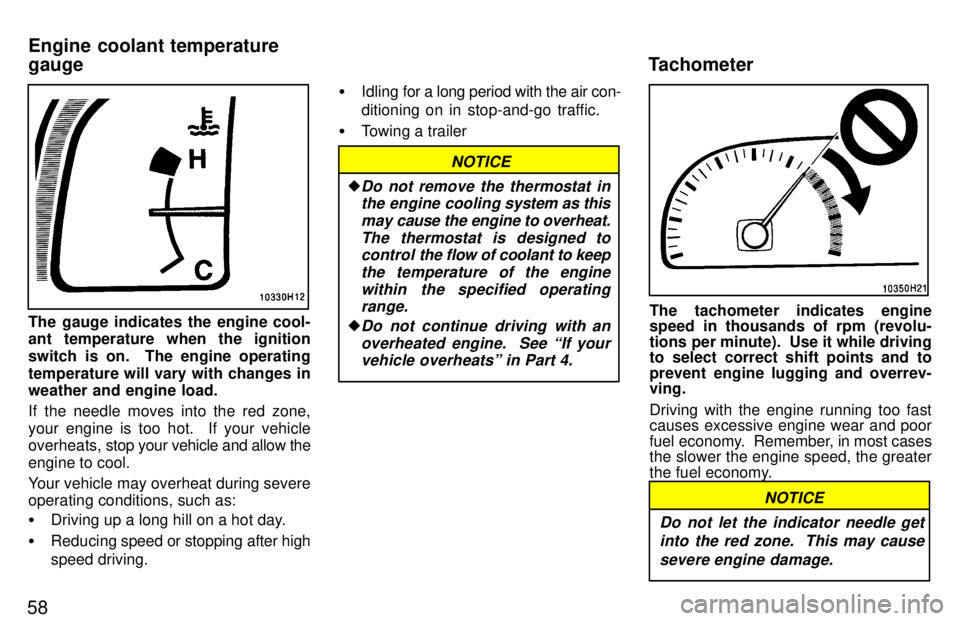
58
The gauge indicates the engine cool-
ant temperature when the ignition
switch is on. The engine operating
temperature will vary with changes in weather and engine load.
If the needle moves into the red zone, your engine is too hot. If your vehicle
overheats, stop your vehicle and allow the
engine to cool.
Your vehicle may overheat during severe operating conditions, such as: � Driving up a long hill on a hot day.
� Reducing speed or stopping after high
speed driving. �
Idling for a long period with the air con-
ditioning on in stop-and-go traffic.
� Towing a trailer
NOTICE
�Do not remove the thermostat in
the engine cooling system as this
may cause the engine to overheat. The thermostat is designed tocontrol the flow of coolant to keep
the temperature of the engine within the specified operatingrange.
�Do not continue driving with an
overheated engine. See If yourvehicle overheatsº in Part 4.The tachometer indicates engine
speed in thousands of rpm (revolu-
tions per minute). Use it while driving
to select correct shift points and to
prevent engine lugging and overrev- ving.
Driving with the engine running too fast
causes excessive engine wear and poor
fuel economy. Remember, in most cases
the slower the engine speed, the greater
the fuel economy.
NOTICE
Do not let the indicator needle get into the red zone. This may cause
severe engine damage.
Tachometer
Engine coolant temperature gauge
Page 68 of 221
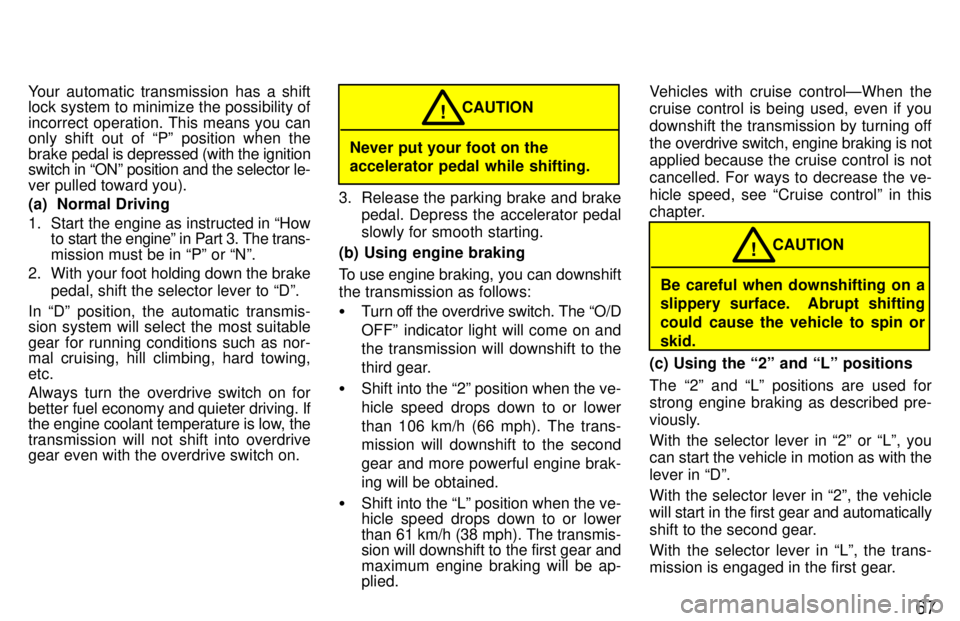
67
Your automatic transmission has a shift
lock system to minimize the possibility of
incorrect operation. This means you can
only shift out of Pº position when the brake
pedal is depressed (with the ignition
switch in ONº position and the selector le-ver pulled toward you). (a) Normal Driving
1. Start the engine as instructed in How to start the engineº in Part 3. The trans- mission must be in Pº or Nº.
2. With your foot holding down the brake pedal, shift the selector lever to Dº.
In Dº position, the automatic transmis-
sion system will select the most suitable
gear for running conditions such as nor-
mal cruising, hill climbing, hard towing, etc.
Always turn the overdrive switch on for
better fuel economy and quieter driving. If
the engine coolant temperature is low, thetransmission will not shift into overdrive
gear even with the overdrive switch on.
Never put your foot on the accelerator pedal while shifting. CAUTION
!
3. Release the parking brake and brake pedal. Depress the accelerator pedal
slowly for smooth starting.
(b) Using engine braking
To use engine braking, you can downshift the transmission as follows: � Turn off the overdrive switch. The O/D
OFFº indicator light will come on and the transmission will downshift to the
third gear.
� Shift into the 2º position when the ve-
hicle speed drops down to or lowerthan 106 km/h (66 mph). The trans- mission will downshift to the second
gear and more powerful engine brak-
ing will be obtained.
� Shift into the Lº position when the ve-
hicle speed drops down to or lower than 61 km/h (38 mph). The transmis- sion will downshift to the first gear and
maximum engine braking will be ap- plied. Vehicles with cruise controlÐWhen the
cruise control is being used, even if you
downshift the transmission by turning off
the overdrive switch, engine braking is not
applied because the cruise control is not cancelled. For ways to decrease the ve-
hicle speed, see Cruise controlº in this
chapter.
Be careful when downshifting on a
slippery surface. Abrupt shifting
could cause the vehicle to spin orskid.
CAUTION
!
(c) Using the 2º and Lº positions
The 2º and Lº positions are used for
strong engine braking as described pre-
viously. With the selector lever in 2º or Lº, you
can start the vehicle in motion as with the
lever in Dº. With the selector lever in 2º, the vehicle
will start in the first gear and automatically
shift to the second gear.
With the selector lever in Lº, the trans-
mission is engaged in the first gear.
Page 69 of 221

68
NOTICE
�To prevent engine overrevving, donot downshift if you are going
faster than the above speed ineach position.
�Be careful not to overrev the en-gine. Watch the tachometer to
keep engine rpm from going intothe red zone. The approximate
maximum allowable speed foreach position is given below for
your reference: 2º 124 km/h (77 mph). . . . . .
Lº 72 km/h (45 mph) . . . . .
�Do not continue hill climbing or
hard towing for a long time in the2º or Lº position. This may
cause severe automatic transmis-sion damage from overheating.
To prevent such damage, use Dºposition for hill climbing or hard
towing.
(d) Backing up
1. Bring the vehicle to a complete stop.
2. With the brake pedal held down with
your foot, shift the selector lever to the
Rº position.
NOTICE
Never shift into reverse while the vehicle is moving.
(e) Parking
1. Bring the vehicle to a complete stop.
2. Pull the parking brake lever up fully to securely apply the parking brake.
3. With the brake pedal pressed down, shift the selector lever to the Pº posi-tion.
While the vehicle is moving, never
attempt to move the selector lever
into Pº position under any
circumstances. Serious mechanical
damage and loss of vehicle control may result. CAUTION
! (f) Good driving practice �
If the transmission is repeatedly up-
shifted and downshifted between third
gear and overdrive when climbing a
gentle slope, the overdrive switch
should be turned off. Be sure to turn the switch on immediately afterward.
� When towing a trailer, in order to main-
tain engine braking efficiency, do not use overdrive.Always keep your foot on the brake
pedal while stopped with the engine
running. This prevents the vehicle
from creeping. CAUTION
!
NOTICE
Do not hold the vehicle on an upgrade with the accelerator pedal.
It can cause the transmission tooverheat. Always use the brake
pedal or parking brake.
Page 72 of 221
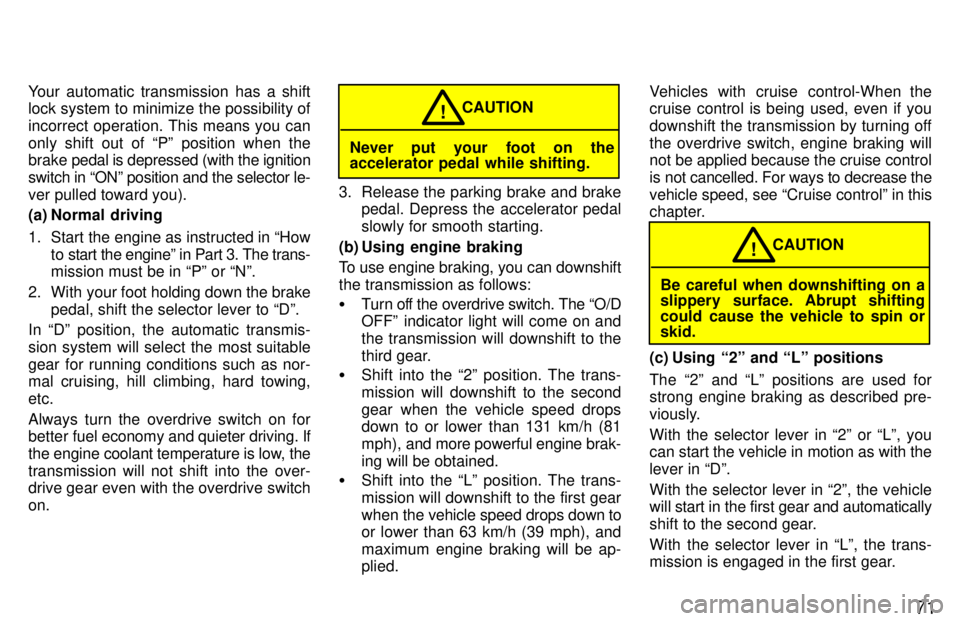
71
Your automatic transmission has a shift
lock system to minimize the possibility of
incorrect operation. This means you can
only shift out of Pº position when the brake
pedal is depressed (with the ignition
switch in ONº position and the selector le- ver pulled toward you).
(a) Normal driving
1. Start the engine as instructed in How to start the engineº in Part 3. The trans- mission must be in Pº or Nº.
2. With your foot holding down the brake pedal, shift the selector lever to Dº.
In Dº position, the automatic transmis-
sion system will select the most suitable
gear for running conditions such as nor-
mal cruising, hill climbing, hard towing, etc.
Always turn the overdrive switch on for
better fuel economy and quieter driving. If
the engine coolant temperature is low, the transmission will not shift into the over-
drive gear even with the overdrive switch on.
Never put your foot on the
accelerator pedal while shifting. CAUTION
!
3. Release the parking brake and brake pedal. Depress the accelerator pedal
slowly for smooth starting.
(b) Using engine braking
To use engine braking, you can downshift the transmission as follows: � Turn off the overdrive switch. The O/D
OFFº indicator light will come on and the transmission will downshift to the
third gear.
� Shift into the 2º position. The trans-
mission will downshift to the second
gear when the vehicle speed drops
down to or lower than 131 km/h (81
mph), and more powerful engine brak-
ing will be obtained.
� Shift into the Lº position. The trans-mission will downshift to the first gear
when the vehicle speed drops down to
or lower than 63 km/h (39 mph), and
maximum engine braking will be ap- plied. Vehicles with cruise control-When the
cruise control is being used, even if you
downshift the transmission by turning offthe overdrive switch, engine braking will
not be applied because the cruise control
is not cancelled. For ways to decrease the
vehicle speed, see Cruise controlº in
this
chapter.
Be careful when downshifting on a
slippery surface. Abrupt shifting
could cause the vehicle to spin or skid. CAUTION
!
(c) Using 2º and Lº positions The 2º and Lº positions are used for
strong engine braking as described pre-
viously. With the selector lever in 2º or Lº, you
can start the vehicle in motion as with the
lever in Dº. With the selector lever in 2º, the vehicle
will start in the first gear and automatically
shift to the second gear.
With the selector lever in Lº, the trans-
mission is engaged in the first gear.
Page 73 of 221
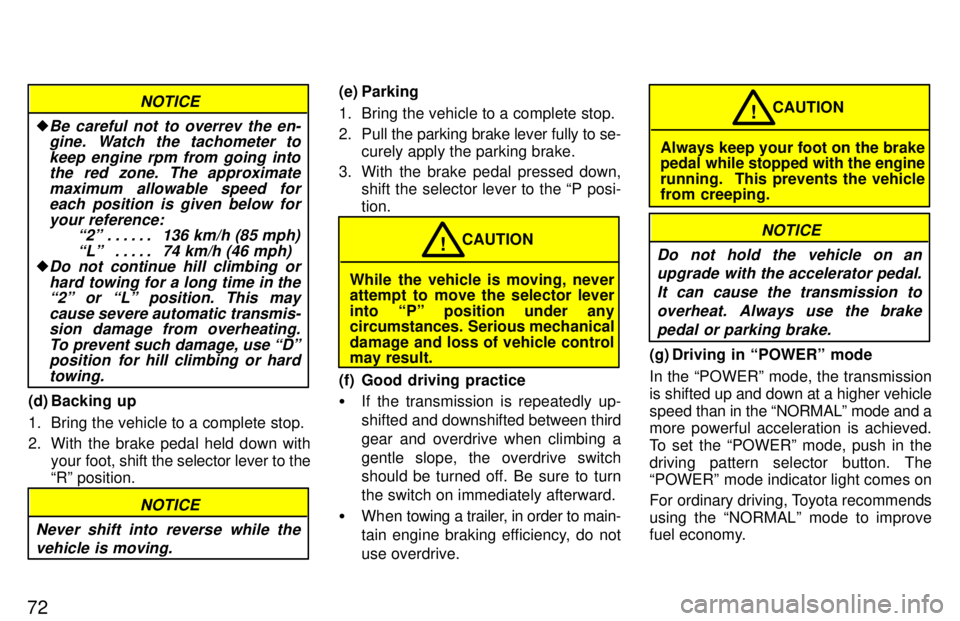
72
NOTICE
�Be careful not to overrev the en-gine. Watch the tachometer to
keep engine rpm from going intothe red zone. The approximate
maximum allowable speed foreach position is given below for
your reference: 2º 136 km/h (85 mph). . . . . .
Lº 74 km/h (46 mph) . . . . .
�Do not continue hill climbing or
hard towing for a long time in the2º or Lº position. This may
cause severe automatic transmis-sion damage from overheating.
To prevent such damage, use Dºposition for hill climbing or hard
towing.
(d) Backing up
1. Bring the vehicle to a complete stop.
2. With the brake pedal held down with
your foot, shift the selector lever to the
Rº position.
NOTICE
Never shift into reverse while the vehicle is moving.
(e) Parking
1. Bring the vehicle to a complete stop.
2. Pull the parking brake lever fully to se-
curely apply the parking brake.
3. With the brake pedal pressed down, shift the selector lever to the P posi- tion.
While the vehicle is moving, never
attempt to move the selector lever
into Pº position under any
circumstances. Serious mechanical
damage and loss of vehicle control may result. CAUTION
!
(f) Good driving practice � If the transmission is repeatedly up-
shifted and downshifted between third
gear and overdrive when climbing a
gentle slope, the overdrive switch
should be turned off. Be sure to turn the switch on immediately afterward.
� When towing a trailer, in order to main-
tain engine braking efficiency, do notuse overdrive.
Always keep your foot on the brake
pedal while stopped with the engine
running. This prevents the vehicle
from creeping. CAUTION
!
NOTICE
Do not hold the vehicle on an upgrade with the accelerator pedal.
It can cause the transmission tooverheat. Always use the brake pedal or parking brake.
(g) Driving in POWERº mode In the POWERº mode, the transmission
is shifted up and down at a higher vehicle
speed than in the NORMALº mode and a
more powerful acceleration is achieved.
To set the POWERº mode, push in the
driving pattern selector button. The
POWERº mode indicator light comes on
For ordinary driving, Toyota recommends
using the NORMALº mode to improve
fuel economy.
Page 76 of 221
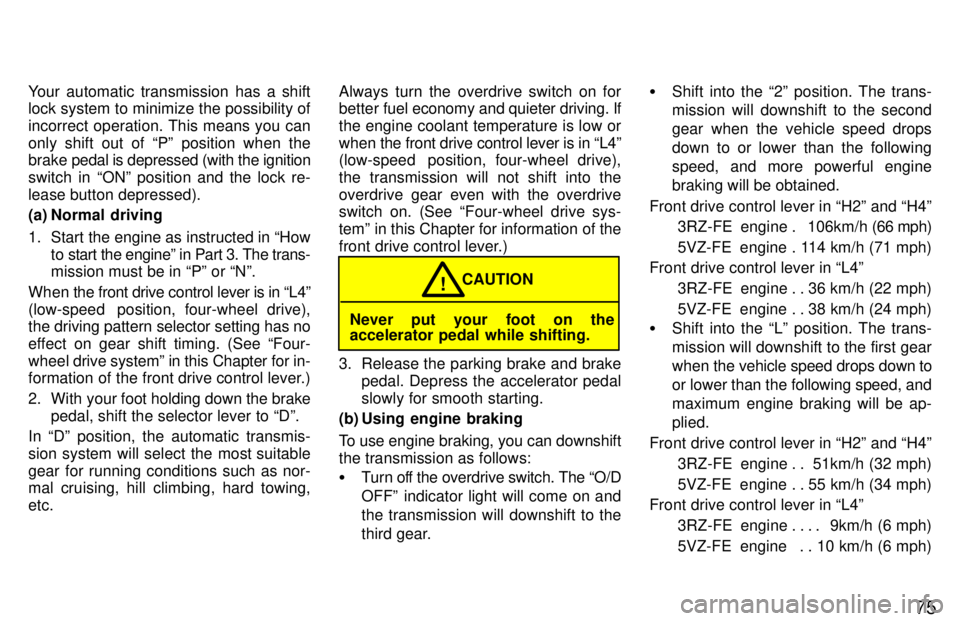
75
Your automatic transmission has a shift
lock system to minimize the possibility of
incorrect operation. This means you can
only shift out of Pº position when the brake
pedal is depressed (with the ignition
switch in ONº position and the lock re-
lease button depressed).
(a) Normal driving
1. Start the engine as instructed in How to start the engineº in Part 3. The trans- mission must be in Pº or Nº.
When the front drive control lever is in L4º
(low-speed position, four-wheel drive),
the driving pattern selector setting has no
effect on gear shift timing. (See Four-
wheel drive systemº in this Chapter for in-
formation of the front drive control lever.)
2. With your foot holding down the brake
pedal, shift the selector lever to Dº.
In Dº position, the automatic transmis-
sion system will select the most suitable
gear for running conditions such as nor-
mal cruising, hill climbing, hard towing, etc. Always turn the overdrive switch on for
better
fuel economy and quieter driving. If
the engine coolant temperature is low or
when the front drive control lever is in L4º
(low-speed position, four-wheel drive),
the transmission will not shift into the
overdrive gear even with the overdrive
switch on. (See Four-wheel drive sys-
temº in this Chapter for information of the
front drive control lever.)
Never put your foot on the
accelerator pedal while shifting. CAUTION
!
3. Release the parking brake and brake pedal. Depress the accelerator pedal
slowly for smooth starting.
(b) Using engine braking
To use engine braking, you can downshift the transmission as follows: � Turn off the overdrive switch. The O/D
OFFº indicator light will come on andthe transmission will downshift to the
third gear. �
Shift into the 2º position. The trans-
mission will downshift to the second
gear when the vehicle speed dropsdown to or lower than the followingspeed, and more powerful engine
braking will be obtained.
Front drive control lever in H2º and H4º 3RZ-FE engine 106km/h (66 mph)
.
5VZ-FE engine 114 km/h (71 mph) .
Front drive control lever in L4º
3RZ-FE engine 36 km/h (22 mph) . .
5VZ-FE engine 38 km/h (24 mph) . .
� Shift into the Lº position. The trans-mission will downshift to the first gear
when the vehicle speed drops down to
or lower than the following speed, and
maximum engine braking will be ap-plied.
Front drive control lever in H2º and H4º 3RZ-FE engine 51km/h (32 mph) . .
5VZ-FE engine 55 km/h (34 mph) . .
Front drive control lever in L4º
3RZ-FE engine 9km/h (6 mph) . . . .
5VZ-FE engine 10 km/h (6 mph) . .
Page 77 of 221
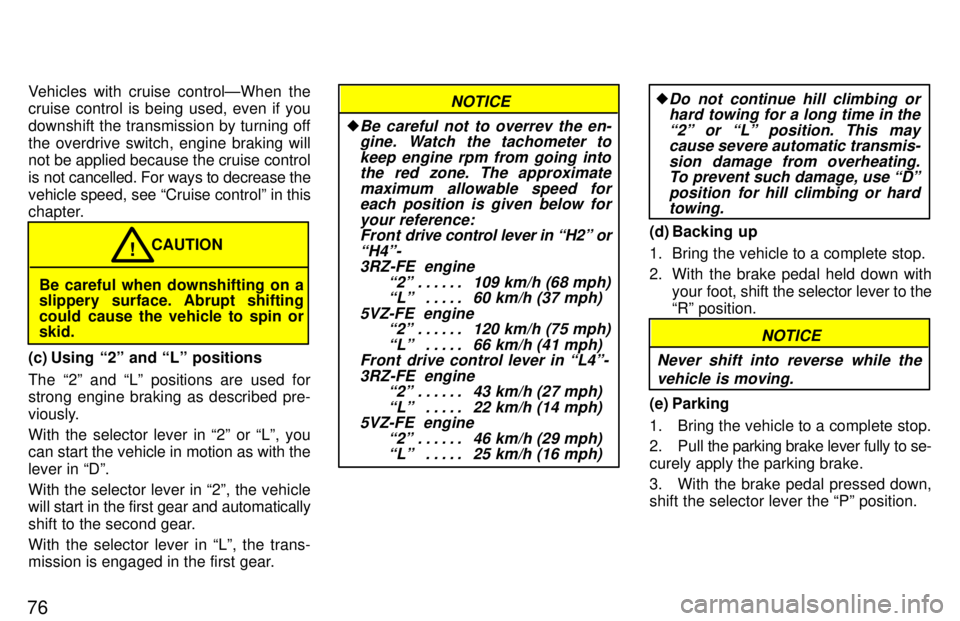
76Vehicles with cruise controlÐWhen the
cruise control is being used, even if you
downshift the transmission by turning offthe overdrive switch, engine braking will
not be applied because the cruise control
is not cancelled. For ways to decrease the
vehicle speed, see Cruise controlº in
this
chapter.
Be careful when downshifting on a
slippery surface. Abrupt shifting
could cause the vehicle to spin or skid. CAUTION
!
(c) Using 2º and Lº positions
The 2º and Lº positions are used for
strong engine braking as described pre-
viously. With the selector lever in 2º or Lº, you
can start the vehicle in motion as with the
lever in Dº. With the selector lever in 2º, the vehicle
will start in the first gear and automatically
shift to the second gear.
With the selector lever in Lº, the trans-
mission is engaged in the first gear.
NOTICE
�Be careful not to overrev the en- gine. Watch the tachometer to
keep engine rpm from going intothe red zone. The approximate
maximum allowable speed foreach position is given below for
your reference:Front drive control lever in H2º or
H4º- 3RZ-FE engine
2º 109 km/h (68 mph). . . . . .
Lº 60 km/h (37 mph) . . . . .
5VZ-FE engine 2º 120 km/h (75 mph). . . . . .
Lº 66 km/h (41 mph) . . . . .
Front drive control lever in L4º-
3RZ-FE engine 2º 43 km/h (27 mph). . . . . .
Lº 22 km/h (14 mph) . . . . .
5VZ-FE engine
2º 46 km/h (29 mph). . . . . .
Lº 25 km/h (16 mph) . . . . .
�Do not continue hill climbing or
hard towing for a long time in the
2º or Lº position. This maycause severe automatic transmis-
sion damage from overheating.To prevent such damage, use Dº
position for hill climbing or hardtowing.
(d) Backing up
1. Bring the vehicle to a complete stop.
2. With the brake pedal held down with
your foot, shift the selector lever to the
Rº position.
NOTICE
Never shift into reverse while the vehicle is moving.
(e) Parking
1. Bring the vehicle to a complete stop.
2. Pull the parking brake lever fully to se-
curely apply the parking brake.
3. With the brake pedal pressed down,
shift the selector lever the Pº position.